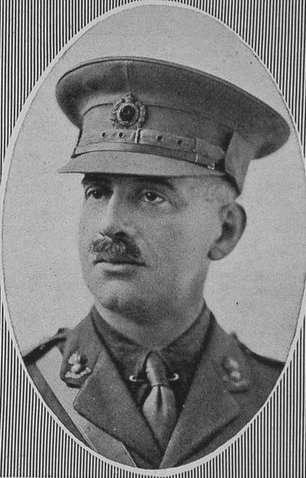
Figure 1. Lieutenant Colonel William Bovet, R.E.
(Image courtesy of the Imperial War Museum)
Lieutenant
Colonel
WILLIAM BOVET
Royal
Engineers
By
Lieutenant Colonel Edward De
Santis, MSCE, PE, MinstRE
(July 2023)

Figure
1. Lieutenant Colonel William Bovet, R.E.
(Image courtesy of
the Imperial War Museum)
1. INTRODUCTION
The principal references used in the preparation of this narrative were from a number of sources. They include a family tree, De Ruvigny’s Roll of Honour, histories of the Corps of Royal Engineers and other books dealing with campaigns in which he served. Many citations were found regarding him in the London Gazette. His service during the Great War of 1914-1918, as presented herein, is based principally on the service of the divisional engineer units for whose activities he was responsible.
All sources are contained in the REFERENCE section at the end of the narrative and are cited throughout in the ENDNOTES. Every effort has been made to accurately portray the life and military service of Lieutenant Colonel Bovet.
Family Information
William Bovet was born at 3 Victoria Street in Westminster, London, S.W. on 15 August 1874. He was the second son of Frederick Bovet (1825-1913), a Merchant of London and Shanghai, China. His mother was Mary Love Bovet, née Haden (1850-1928) of Chelsea, London.[1]
Education
William was educated at Grosvenor School and Twickenham, then at University College School on Gower Street, London, W.C. and finally as a Gentleman Cadet at the Royal Military Academy at Woolwich.[2]
Until 1870 prospective officers in the British Army had for the most part to purchase their commissions, and education or training was not seen as a requirement for the rôle. The Board of Ordnance's establishment of a Military Academy represented a very different approach, whereby training and education were obligatory for aspiring officers of its corps, and promotion was offered according to merit (those with highest achievement in their exams being given the first choice of opportunities). William Bovet was able to qualify for admission to the R.M.A. and to receive an education that gave him an opportunity to serve in the Corps of Royal Engineers. At Woolwich his studies included mathematics, land-surveying, mapping, fortifications, engineering, the use of the rifle and pistol and sword exercises, and the use of this knowledge and training on the battlefield.
3. COMMISSIONING AND TRAINING
Commissioning
Following the successful completion of his studies at Woolwich, William Bovet was commissioned a 2nd Lieutenant in the Royal Engineers on 25 July 1893.[3] He was then sent off to the School of Military Engineering at Chatham, Kent for further training in military subjects.[4]
Training
Bovet’s professional and technical instruction at the School of Military Engineering included field fortifications, construction, surveying, telegraphy, electric lighting, submarine mining, photography, chemistry, military law and tactics. These courses of instruction would keep him at Chatham for about two years before he was posted to his first unit.[5]
4. POSTINGS AND CAMPAIGN SERVICE
India (1895-1903)
In 1895 2nd Lieutenant Bovet proceeded from Chatham to India where he joined the 3rd Bombay Sappers and Miners (S. & M.) at Kirkee. On 25 July 1896, while serving at Kirkee, he was promoted to the rank of Lieutenant.[6]
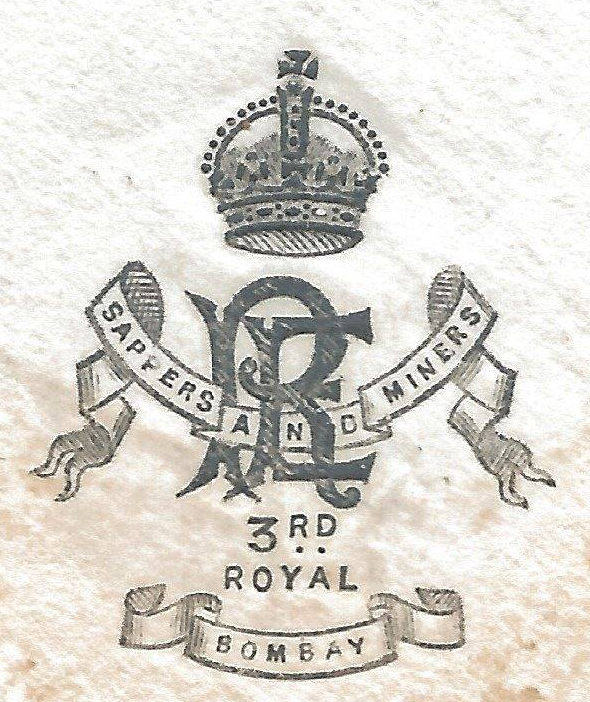
Figure
2. Crest of the 3rd Bombay Sappers and
Miners.
(Image courtesy of Wikipedia)
On 21 January 1898, a detachment of the 1st Company, Bombay Sappers & Miners, consisting of an Indian officer and 12 other ranks under Lieutenant Bovet, embarked at Bombay for Makran and landed six days later at Pasni. From there they marched to join a small force under Lieutenant Colonel R. C. G. Mayne, Bombay Infantry (B.I.), at Turbat, which they reached on 2 February. Mayne was engaged in subduing an outlaw named Mehrab Khan, who had seized Turbat Fort, but shortly before the Sappers arrived Mehrab escaped and was reported to be making for Churbuk. The Sappers had marched 40 miles on the 2nd ; yet they set out with other troops on the 3rd , and after covering a further 30 miles, assisted in the capture and destruction of Churbuk Fort. That they were able to accomplish the feat of marching 70 miles through broken country in 48 hours was due to the determination of their leader, William Bovet, a keen soldier and ardent pigsticker. During the remainder of the expedition to Makran in 1898, Bovet and his men destroyed a number of forts and afterwards proceeded through Kalat to Quetta, where they arrived on 16 April en route for Kirkee.[7]
Somaliland (1903-1904)
Bovet’s next stint of active service took place in Somaliland to deal with the Mad Mullah, Sayid Mohamed Abdullahi Hassan. He was a Somali religious, military and political leader who headed the Somali Dervish movement in a two-decade long struggle against British, Italian, and Ethiopian influence in the region.
The following is an extract of the British campaign in Somaliland as described by Sandes. Note that much of the account given below was provided by Captain Bovet in notes given to Lieutenant Colonel (retd.) F.S. Garwood, R.E. and then sent to E.W.C. Sandes on 18 February 1938.
“The main expeditionary force of about 2,000 men, under the command of Lieutenant Colonel (local Brigadier General) W. H. Manning, B.I., was landed at Obbia in January 1903. The Commanding Royal Engineer was Captain W. B. Lesslie, R.E., and included in the force was the 17th Company, Bombay S. & M., under Captain W. Bovet, R.E., with Lieutenant E. D. Tillard, R.E. This unit had come directly from Bombay with other Indian troops, the remaining units of the Obbia Force being supplied from Berbera and South Africa. The Berbera Force, operating from the north under the command of Major (local Lieutenant Colonel) J. C. Swann, Bombay Infantry, included the detachment of the 19th Company, Bombay S. & M., under Lieutenant A. L. Paris, R.E. Its chief duty was to keep open the line of communication between Berbera and Bohotle while the Obbia Force drove the Mullah from Mudug.
General Manning marched from Obbia on 22 February 1903, and reached Galkayu on 5 March, but lack of transport and supplies obliged him to halt there. Meanwhile, Colonel Swann had occupied Damot. Manning planned next to advance westwards against the Mad Mullah, who had moved to Galadi, and although his fighting strength had fallen to 800 men he reached that place safely on 31 March only to find that the Mullah had retired still further westwards towards Wardair.
On 17 April, a disaster occurred near Gurnburru where a column of 223 men under Captain (local Lieutenant Colonel) A. W. V. Plunkett, Central African Rifles, marched out to the attack and was annihilated by a horde of 8,000 Somalis. A few days later, another column had a very hard fight at Daratoleh. On 26 June Manning established contact with Swann's advanced troops at Bohotle, but he was too late because the Mullah had already slipped through between the converging forces. By a daring march northeastward, the Somali leader had traversed the Southern Haud from the region of Wardair and Gerlogubi and had reached the Nogal Valley. The British operations had failed through lack of transport. It was decided to close the Obbia line of communication, and Manning moved on towards Berbera, leaving garrisons at Bohotle, Kirrit and Burao. Most of the troops went down to the coast; but the Sappers and Miners remained in the interior to make defensible posts, improve the desert tracks, and arrange for water supply in preparation for a renewed offensive.
For the final campaign against the Mad Mullah, the force in Somaliland was increased to 6,400 men and placed under the command of Major General Sir C. C. Egerton. Brigadier General Manning commanded the African troops forming the 1st Brigade, and Lieutenant Colonel (local Brigadier General) C. G. M. Fasken, B.I., commanded the 2nd or Indian Brigade. There was also a Mounted Brigade under Major (local Lieutenant Colonel) P.A. Kenna. An advanced base was established at Kirrit, and strong working parties of Indian infantry assisted the 107th Pioneers in making a cart road over the Sheikh Pass and improving the route through Burao. Thousands of camels were purchased for transport purposes, and depots of supplies laid out.
In August 1903, the greater part of the 19th Company, Bombay S. & M., under Captain W. H. Chaldecott, R.E., landed at Berbera on transfer from the Aden Hinterland and moved into the interior to reinforce the detachment under Paris and the 17th Company under Bovet. Major R. F. Allen, R.E., became Commanding Royal Engineer, and an Engineer Field Park of Madras Sappers and Miners made its appearance under Major E. P. Johnson, R.E. The 17th Company was attached to the 1st Brigade, and the 19th Company to the 2nd Brigade when acting independently. By the end of October 1903, all the necessary preparations for a general advance had been completed. The 1st Brigade moved to Bohotle and the 2nd Brigade to Eil Dab, the Mad Mullah being then in the southern part of the Nogal Valley. As it was feared that the Mullah might retreat into the Southern Haud, the Abyssinians were asked to occupy Galadi. This, however, they could not undertake, so the 1st Brigade was sent straight across the Haud to carry out the task. Bovet and a detachment of the 17th Company went with the brigade on this journey of 95 miles across waterless country. Galadi was garrisoned and the 1st Brigade then returned, encountering and defeating a raiding party of the enemy on the way.
As it was reported, early in December, that the Mad Mullah was moving westwards up the Nogal Valley and concentrating at Jidbali, and as it was hopeless to expect the Abyssinians to reach Galadi in reasonable time, Egerton recalled the Galadi garrison and marched from Eil Dab on 8 January 1904, with the 2nd Brigade and mounted troops, to meet the 1st Brigade coming up from Bohotle. The Mullah was located with 6,000 men at Jidbali, and in January the two brigades advanced in square formation to attack him, the 17th and 19th Companies of Bombay Sappers being with the infantry in the firing line. The enemy's skirmishers could be discerned lying down in short grass within 700 yards of the square or creeping slowly forward through the scrub, and the crackle of musketry deepened into a deafening roar as the square was attacked on the front and both flanks; but the extended lines of the Somalis soon melted away under a hail of bullets, and within half an hour, the survivors were in full flight, pursued by mounted troops. They left 660 dead on the field and many more strewn along the line of retreat.
The 1st Brigade moved to Bohotle and the 2nd Brigade to Eil Dab, the Mad Mullah being then in the southern part of the Nogal Valley. As it was feared that the Mullah might retreat into the Southern Haud, the Abyssinians were asked to occupy Galadi. This, however, they could not undertake, so the 1st Brigade was sent straight across the Haud to carry out the task. Bovet and a detachment of the 17th Company went with the brigade on this journey of 95 miles across waterless country. Galadi was garrisoned and the 1st Brigade then returned, encountering and defeating a raiding party of the enemy on the way. A certain Royal Engineer, well known in India, once expressed his opinion of the value of Somaliland in the words "When I see a bad egg lying in the gutter, I do not pick it up." A pessimist perhaps; but Bovet, after his experiences in the Southern Haud, might have felt inclined to agree with him. The Sappers were often reduced to drinking water so foul that no man would wash his hands in it. Rations were always scarce, and the allowance of jam in the officers' mess was one spoonful a day.' Each man had to carry 40 lbs. of kit - no small load under the burning rays of a tropical sun. The troops rested during the heat of the day under improvised shelters of blankets and sticks; but the marching hours-dawn till sunset-were enough to try the strongest constitution.
Egerton now planned to occupy the southern edge of the Nogal Valley to prevent the Mullah from escaping southwards to the Mudug oases, and as the Mullah was believed to be near Hansoga, the two brigades were directed at first on Halin at the east end of the valley. Subsequently, the 1st Brigade was detailed to hold the Nogal Valley, while the 2nd Brigade and mounted troops reconnoitered the Haisimo District to the north. The 17th Company marched down the Nogal with the 1st Brigade and assisted in the capture of 20,000 camels and 50,000 sheep which formed the Mullah's chief reserves of transport and supply. This brigade also blocked the passes leading from the Nogal into the Sorl or Northern Haud. Meanwhile, the 2nd Brigade marched back with the 19th Company to Eil Dab, and thence towards Berbera, preparatory to taking up the chase of the Mullah in the Northern Haud. A party of the 19th Company was attached to a movable column despatched from Eil Dab, and another of the 17th Company set out with a column under Brigadier General Fasken which assembled east of the Sheikh Pass. The two columns met at Al Afweina on 15 March 1904, and then advanced to Jid Ali, and later to Las Khorai on the coast, where another detachment of Sappers was at work.
The pursuit of the Mullah was resumed to the region of Rat and Ansaneh but without result, and at the Italian frontier it had to be abandoned. Fasken retired to Las Khorai and reached that place on 10 April. With the escape of the remnants of the Mad Mullah's army into the north-eastern corner of Italian Somaliland, the military operations came to an end and the troops were withdrawn gradually to Berbera, some by land and others by sea from Las Khorai. By the end of May 1904, the bulk of the expeditionary force had reached the base, and on 14 June the 17th and 19th Companies of the Bombay Sappers were back in their headquarters at Kirkee. They had found the campaign extremely arduous, but [most] had earned for their Corps the honour "Somaliland, 1901- 04."[8]
For his service in Somaliland Captain Bovet was mentioned in the despatch of Major General Sir Charles Egerton for excellence with Engineer Work. Egerton had this to say about Bovet’s service:
“Lieutenant W. Bovet, R.E., No. 17 Company, Sappers and Miners. This Officer has been through the whole campaign, from the landing at Obbia to the end of operations. He and his company have done very meritorious work.”[9]
NOTE: Bovet had been promoted to Captain on 1 April 1904, so he was a Lieutenant for the major part of his time in Somaliland, but a Captain at the time that his Mention in Despatches was gazetted.
India and Egypt (1904-1916)
Following his return to India, Captain Bovet was assigned to train Indian officers and recruits serving in the Bombay Sappers and Miners. He was promoted to Major on 25 July 1913[10] and was appointed the Acting Commander Royal Engineers at Kirkee.[11] He was still in India in August of 1914 when the Great War broke out.[12]
According to his Medal Index Card (MIC), Major Bovet qualified for the 1914-15 Star in November of 1915. It is assumed that this is when he left India for Egypt where he arrived in January 1916. He was posted to the Egyptian Expeditionary Force (E.E.F.) for a very short time in an unknown capacity. In March he proceeded to France.[13]
France (1916-1918)
Upon his arrival in France he was posted to one of the ANZAC Divisions.[14] Again, his specific assignment is unknown. As a Major in the Royal Engineers it is likely that he may have been posted to the staff of the Commander Royal Engineers of the division.
Major Bovet was posted from the Australian division to the British 12th (Eastern) Division at Arras in time for the Battle of the Somme in July of 1916. He replaced Lieutenant Colonel S.F. Williams, C.M.G., R.E.[15] as the division’s Commander Royal Engineers (C.R.E.). Williams had been the division’s C.R.E. since August 1914 when the division was formed.[16]
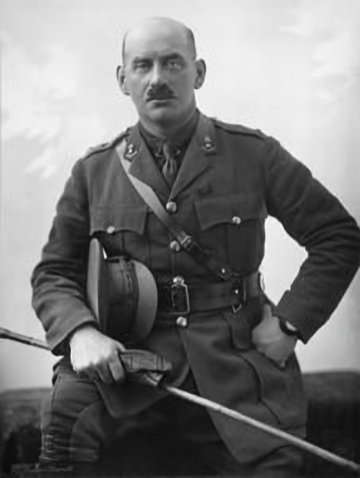
Figure
3. Major William Bovet, R.E.
(Image courtesy of the Imperial
War Museum)
As the 12th Division was in the British III Corps, Bovet was subordinate to the division commander, Major General Arthur B. Scott, and the Corps Chief Engineer, Brigadier General A.L. Schreiber. The units of the Royal Engineers that Major Bovet commanded consisted of the 69th , 70th and 87th Field Companies and the 12th Divisional Signal Company.[17]
The initial phase of the Battle of the Somme lasted from 1 to 13 July 1916. It is assumed that Major Bovet was with the 12th Division for at least part of this time. On 22 July 1916 he was appointed to the temporary rank of Lieutenant Colonel in keeping with his position as the division’s C.R.E.[18] From 23 July to 3 September 1916 the 12th Division R.E. units all took part in the Battle of Pozieres and were at Arras for the defence of the southern suburbs of the city.[19] The Battle of the Somme ground on into the autumn and from 1 to 9 October 1916 the 12th Division was involved in the actions at Gueudecourt and Bayonet Trench. The division’s field companies were occupied during this period digging communication trenches for each of the two infantry brigades on line and repairing the road from Longueval to Flers for wheeled transport.
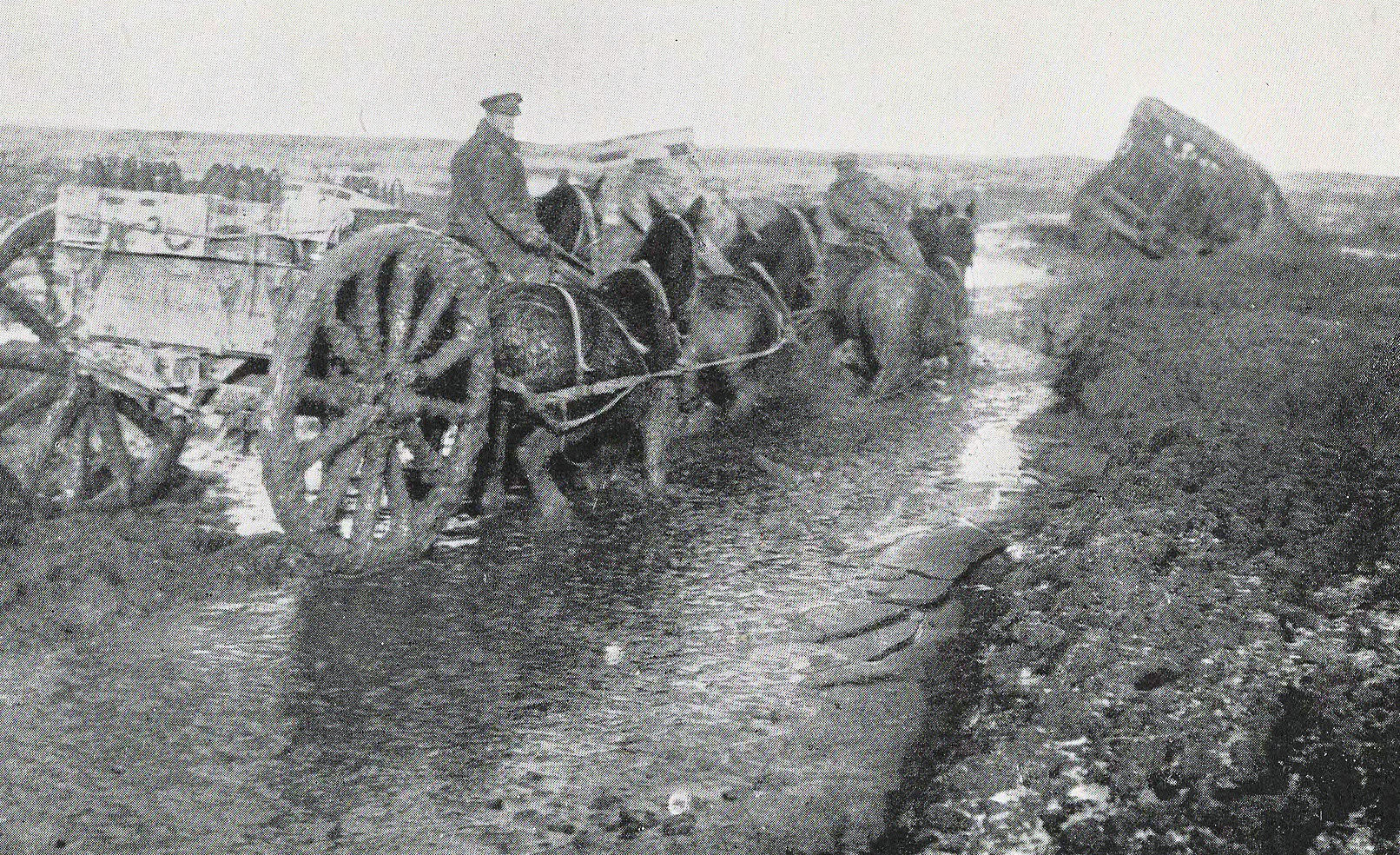
Figure
4. The Flooded Roads in the 12th Division
Sector.
(Image courtesy of Wikipedia)
During the period from 1-18 October 1916 the field companies were located in the vicinity of Le Transloy and were credited with participation in the battle there.[20]
The 12th Division spent the winter from November 1916 to January 1917 on the line. On 1 January Bovet was promoted to the rank of Brevet Lieutenant Colonel, an upgrade from his temporary rank[21] and on 4 January 1917 he was mentioned in the despatches of Field Marshal Sir Douglas Haig for “gallant and distinguished service in the field.”[22]
From January to March 1917 the 12th Division prepared for offensive action and from 4 April to 16 May it was involved in the Battle of Arras.
In the trenches, in addition to the dug-outs, brigade and battalion Headquarters, trench mortar emplacements, aid posts, a dressing station, bridges to cross the trenches and various stores had been made. The caves were fitted with sleeping bunks, kitchens, water supply, sanitation, and electric light. A tunnel ran from the Main Sewer through the caves to the front, and in this a tram line was laid. The expert work naturally fell on the field companies of the Royal Engineers, and on the Pioneer Battalion (5th Northamptonshire Regiment) under Lieutenant Colonel Trent. The amount of wood required was enormous, and entailed the purchase of standing trees in the woods at Le Cauroy, from whence they were transferred to a saw mill at Prevent, which ran continuously with eight-hour shifts. The timbers were then taken to workshops at Louez and finished off. The control of all this work was under the divisions Commanding Royal Engineer, Lieutenant Colonel Bovet, and to him and his adjutant, Captain Lee Norman, the highest credit was due.
During the first days of April the artillery, which had been largely augmented, came into position. Tanks were concentrated, reserve divisions closed up, and on the 3rd the 12th Division troops moved to their battle areas, divisional headquarters going to Wagnonlieu.
Every detail for the coming attack had been practiced by the troops, every requirement for their accommodation, movement and supply had been arranged. The streets of Arras were smothered in direction signs, and it was possible to go from the entrance of the Main Sewer near the Petite Place to half-way across No Man's Land under ground. The final preparations for the Battle of Arras were complete.
Battle honours for Lieutenant Colonel Bovet’s engineers during this period included:[23]
· The First Battle of the Scarpe, 9-14 April
· The Battle of Arleux, 28-29 April
· The Second Battle of the Scarpe, 3-4 May
From 17 May to 19 October 1917 the 12th Division was involved with the defence of Monchy-Le-Preux. The division’s three field companies took part in trench raids for demolition purposes and destroyed 14 German dugouts. No. 3 Special Company of the Royal Engineers assisted in the raids with thermite and smoke screens on the flanks of the attacking units.[24]
The 12th Division took part in the attack in the First Battle of Cambrai from 20 October to 26 November 1917. All the field companies and the division Pioneer Battalion (5th Northamptonshires) were sent ahead to form shelters and erect huts, these being carefully camouflaged. The units also constructed camouflaged gun positions. The 12th Divisional Signal Company also was in the First Battle of Cambrai from 20 November to 3 December 1917.[25]
The Germans counter-attacked the 12th Division from 27 November to 7 December. The 69th Field Company formed a strong point at Revelon Farm with the 5th Northamptonshires. The 70th Field Company also was sent into the line to fight as infantry.
On 30 November 1917 Lieutenant Colonel Bovet was wounded in action, but he returned to duty the following month. The 69th Field Company was still in the line at Revelon Farm, while presumably the other two field companies were employed on engineer works. The First Battle of Cambrai ended on 7 December.
Lieutenant Colonel Bovet was again mentioned in the despatches of Field Marshal Sir Douglas Haig for his gallant and distinguished service in the field.[26] One can imagine that Bovet, as the Commander Royal Engineers, spent much time up front with his field companies during the German counter-attack in November and December of 1917. For his command presence in the field he probably came to the notice of the Field Marshal.
From December 1917 to 24 March 1918 the 12th Division was in winter quarters, probably in III Corps reserve.[27] All the R.E. field companies and the divisional signal company also were in rear area positions.
The large German spring offensive began on 25 March 1918. The R.E. units of the 12th Division were involved in the following actions during this offensive:[28]
· The Battle of Bapaume from 24 – 25 March involved the 70th and 87th Field Companies and the 12th Divisional Signal Company.
· The Battle of Arras on 28 March in which all divisional engineer companies were involved.
· The Battle of Ancre on 5 April, where again all divisional engineer units were involved.
From 18 April to 4 July 1918 the 12th Division continued to defend against the German offensive. On 5 July Lieutenant Colonel Bovet was critically wounded in action. He was evacuated to No. 3 Casualty Clearing Station where he died from his wounds. He was 43 years old.
The 12th Division history recorded this of his passing:
“The division sustained a great loss in the death of Lieutenant Colonel Bovet, D.S.O., who was mortally wounded near Bouzincourt on his way back from the trenches. Lieutenant Colonel Bovet had held the appointment of CRE for nearly two years, and had served with great distinction, showing great zeal and ability in all his duties.”
Bovet was replaced as C.R.E. of the division by Lieutenant Colonel Arthur Talbot Shakespear, D.S.O., M.C.
William Bovet was buried in the British Military Cemetery at Doullens. The inscription on his grave reads:
THEIR GLORY SHALL NOT BE BLOTTED OUT
THEIR NAME LIVETH FOREVER MORE
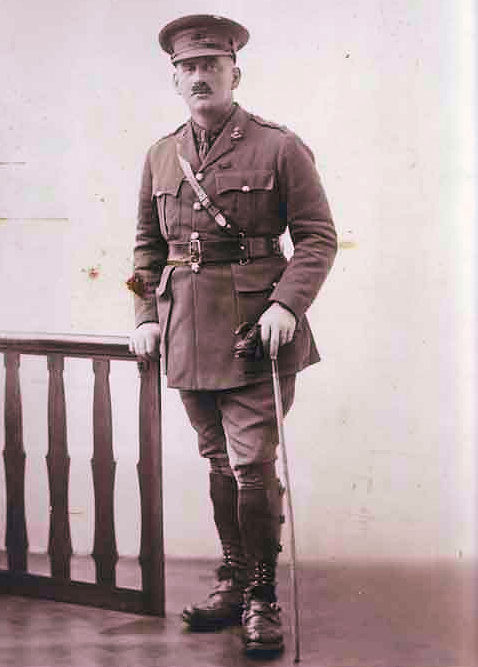
Figure
5. Lieutenant Colonel William Bovet, R.E.
(Image courtesy of
the Imperial War Museum)
---------------------------------------------------------------------------------------------------------------
The following sections are tabular summaries of Bovet’s promotions, appointments, medals and awards and a summary of his military service.
5. PROMOTIONS AND APPOINTMENTS
Promotions: Bovet received the following promotions during his time in service:
Date of Promotion or Appointment |
|
25 July 1893 |
Second Lieutenant, upon commissioning in the Royal Engineers |
25 July 1896 |
Promoted Lieutenant |
1 April 1904 |
Promoted Captain |
25 July 1913 |
Promoted Major |
22 July 1916 |
Appointed Temporary Lieutenant Colonel |
1 January 1917 |
Promoted Brevet Lieutenant Colonel |
Appointments: Bovet received the following appointments during his time in service:
Date of Appointment |
|
25 July 1896 |
Section Officer, Indian Sappers & Miners Field Company |
16 April 1898 |
Commander, Indian Sappers & Miners Field Company |
August 1914 |
Acting Commander Royal Engineers, Kirkee, India |
22 July 1916 |
Commander Royal Engineers, 12th Division. |
MEDALS, AWARDS AND DECORATIONS
William Bovet received the Africa General Service Medal with clasp [SOMALILAND 1902-04] and [JIDBALLI]. For his service in the Great War he received the 1914-15 Star, British War Medal and Victory Medal. These medals are shown from left to right in the Figure below. The medals shown are not those of Lieutenant Colonel Bovet. They are provided here for illustrative purposes only.
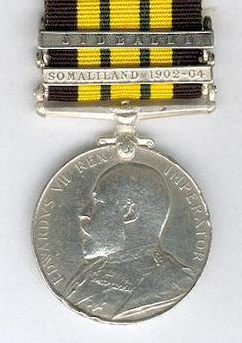
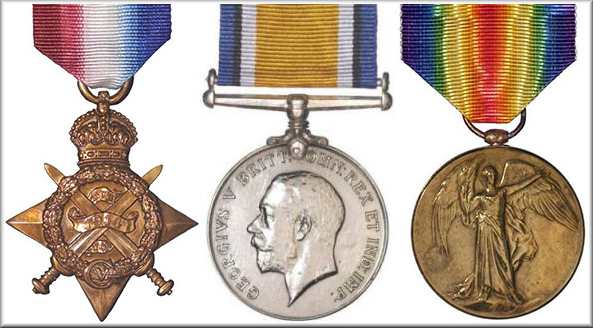
Figure 6. The Medals That Would Have Been Awarded to William
Bovet.
(Images from the author’s collection)
Since Lieutenant Colonel Bovet was twice mentioned in despatches for his service during the Great War, his victory medal would have an oak leave emblem mounted on it as shown in the Figure below.
Various references indicate that Lieutenant Colonel Bovet had been awarded the C.M.G. or the D.S.O., or both. No document has been found to verify either one of these awards. A search of the London Gazette during the period of the Great War did not reveal either award nor does his memorial by the Commonwealth War Graves Commission does not show either award. Bovet was a brave and conscientious officer, traits that were demonstrated early in his military career in Somaliland when he was mentioned in despatches for his service there. His gallant and distinguished service was mentioned twice in despatches during the Great War. If he did not receive the C.M.G. or the D.S.O., it is very difficult to believe that he was not at least awarded the Military Cross; however, no citations for any of these awards were located during this research project.
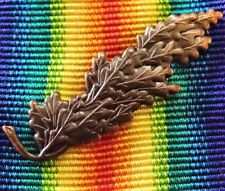
Figure
7. The Victory Medal with M.I.D. Oak Leaf.
(Image from the
author’s collection)
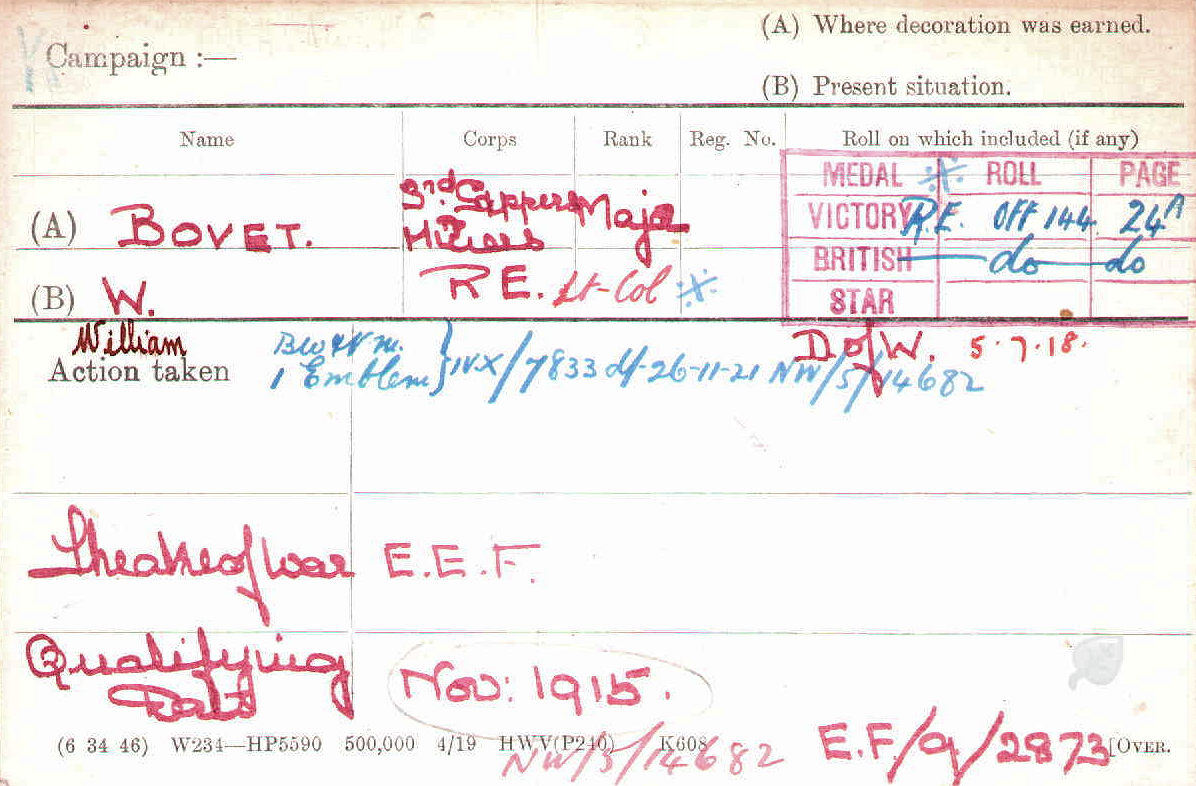
Figure
8. The Medal Index Card of Lieutenant Colonel William Bovet,
R.E.
(Image courtesy of Ancestry.com)
7. SUMMARY OF SERVICE
Location |
|
Chatham, Kent |
25 July 1893 to 1895 |
Kirkee, India |
1895 to 20 January 1898 |
Baluchistan |
21 January 1898 to 16 April 1898 |
Kirkee, India |
17 April 1898 to January 1903 |
Somaliland |
January 1903 to September 1904 |
Kirkee, India |
September 1904 to November 1915 |
Egypt |
November 1915 to March 1916 |
France |
March 1916 to 5 July 1918 |
William Bovet served for a total period of 24 years, 11 months and 11 days before his death in France. Of that time approximately 23 years and 1 month was spent abroad.
REFERENCES:
Books
BAKER BROWN, W. The History of the Corps of Royal Engineers, Volume IV, 1885-1914. The Institution of Royal Engineers, Chatham, Kent, 1952.
The History of the Corps of Royal Engineers, Volume V. The Institution of Royal Engineers, Chatham, Kent, 1952.
De RUVIGNY, M. De Ruvigny Roll of Honour, Uckfield [England] : The Naval & Military Press [199-?]
SANDES, E.W.C. The Indian Sappers and Miners. The Institution of Royal Engineers, Chatham, Kent, 1948.
SCOTT & BRUMWELL. History of the 12th (Eastern) Division in the Great War, 1914-1918. Nisbet & Co. Ltd., London, 1923.
Civil Documents
Commonwealth War Graves Commission Index No. Fr. 84, Bagneux British Cemetery, Gezaincourt. (CWGC)
Family Tree
Lieutenant Colonel William Bovet (by classicalnut)
Internet Web Sites
Wikipedia: The Royal Military Academy, Woolwich.
https://en.wikipedia.org/wiki/Royal_Military_Academy,_Woolwich
London Gazette and Edinburgh Gazette
The London Gazette, 1 August 1893, p. 4356.
The London Gazette, 11 August 1896, p. 4573.
The London Gazette, 22 July 1904, p. 4759.
The London Gazette, 2 September 1904, p. 5683.
The London Gazette, 25 July 1913, p. 5323.
Supplement to the London Gazette, 13 November 1916, p. 10952.
Supplement to the London Gazette, 29 December 1916, pp. 15 and 16.
Supplement to the Edinburgh Gazette, 1 January 1917, pp. 15 and 16.
Supplement to the London Gazette, 4 January 1917, pp. 191 and 193.
Military Documents
Medal Index Card
Periodicals
The Royal Engineers Journal. Battle Honours of the Royal Engineers. The Institution of Royal Engineers, Chatham, Kent, 1925-1932.
ENDNOTES:
[1] Family tree.
[2] The Royal Military Academy (RMA) at Woolwich, in south-east London, was a British Army military academy for the training of commissioned officers of the Royal Artillery and Royal Engineers. It later also trained officers of the Royal Corps of Signals and other technical corps. RMA Woolwich was commonly known as "The Shop" because its first building was a converted workshop of the Woolwich Arsenal.
[3] London Gazette, 1 August 1893.
[4] De RUVIGNY.
[5] Wikipedia.
[6] London Gazette, 11 August 1896.
[7] SANDES, p. 318.
[8] Bovet had earned the medal with the clasps [SOMILAND 1902-04] and {JIDBALI].
[9] London Gazette, 2 September 1904.
[10] London Gazette, 25 July 1913.
[11] De RUVIGNY.
[12] Ibid.
[13] Ibid.
[14] Ibid.
[15] Williams was later a Brigadier General. He died on 12 July 1942.
[16] History of the 12th Division in the Great War.
[17] Note that the location of Bovet during the war in France, as presented in this narrative, is based on the general locations of the units under his command. The unit locations are based on the History of the 12th Division and the Battle Honours of the Royal Engineers as cited in REFERENCES.
[18] London Gazette, 13 November 1916.
[19] History of the 12th Division in the Great War and Battle Honours of the Royal Engineers.
[20] Battle Honours of the Royal Engineers.
[21] London Gazette, 1 January 1917.
[22] London Gazette, 4 January 1917.
[23] Battle Honours of the Royal Engineers.
[24] History of the 12th Division in the Great War.
[25] History of the 12th Division in the Great War and Battle Honours of the Royal Engineers.
[26] London Gazette, 11 December 1917.
[27] History of the 12th Division in the Great War.
[28] History of the 12th Division in the Great War and Battle Honours of the Royal Engineers.